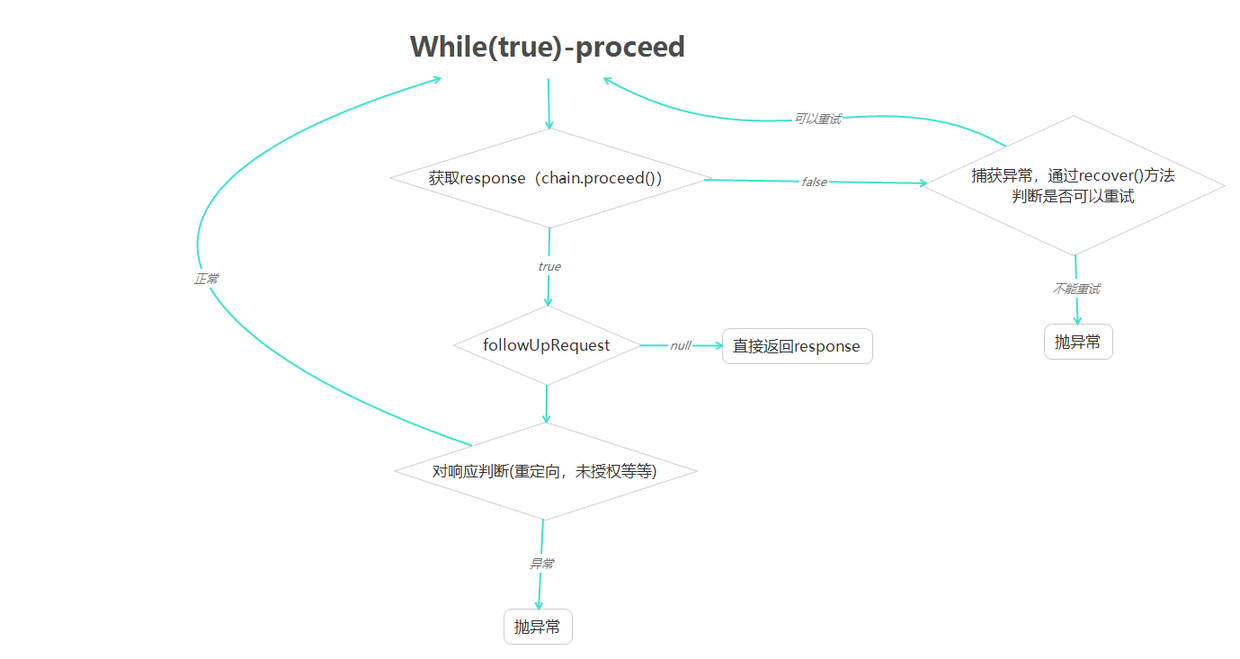Preface
Review: Basic usage of Okhttp Okhttp3 Source Parsing (1)-OkHttpClient Analysis Okhttp3 Source Parsing (2)-Request Analysis Okhttp3 Source Parsing (3)-Call Analysis (Overall Process) Okhttp3 Source Parsing (4) - Interceptor and Design Mode
The previous section talks about interceptors and design patterns, and today we talk about RetryAndFollowUpInterceptor. If we don't customize interceptors, RetryAndFollowUpInterceptor is the first interceptor.
Initialization
First look at where RetryAndFollowUpInterceptor was added:
 Initialization location:
call instantiation method:
Initialization location:
call instantiation method:
private RealCall(OkHttpClient client, Request originalRequest, boolean forWebSocket) { this.client = client; this.originalRequest = originalRequest; this.forWebSocket = forWebSocket; this.retryAndFollowUpInterceptor = new RetryAndFollowUpInterceptor(client, forWebSocket); }
Location of initialization found, go to RetryAndFollowUpInterceptor species analysis below!
RetryAndFollowUpInterceptor Resolution
We know from the previous section that intercept() is the core of the interceptor!Paste the code here:
@Override public Response intercept(Chain chain) throws IOException { Request request = chain.request(); RealInterceptorChain realChain = (RealInterceptorChain) chain; Call call = realChain.call(); EventListener eventListener = realChain.eventListener(); StreamAllocation streamAllocation = new StreamAllocation(client.connectionPool(), createAddress(request.url()), call, eventListener, callStackTrace); this.streamAllocation = streamAllocation; int followUpCount = 0; Response priorResponse = null; while (true) { if (canceled) { streamAllocation.release(); throw new IOException("Canceled"); } Response response; boolean releaseConnection = true; try { response = realChain.proceed(request, streamAllocation, null, null); releaseConnection = false; } catch (RouteException e) { // The attempt to connect via a route failed. The request will not have been sent. if (!recover(e.getLastConnectException(), streamAllocation, false, request)) { throw e.getFirstConnectException(); } releaseConnection = false; continue; } catch (IOException e) { // An attempt to communicate with a server failed. The request may have been sent. boolean requestSendStarted = !(e instanceof ConnectionShutdownException); if (!recover(e, streamAllocation, requestSendStarted, request)) throw e; releaseConnection = false; continue; } finally { // We're throwing an unchecked exception. Release any resources. if (releaseConnection) { streamAllocation.streamFailed(null); streamAllocation.release(); } } // Attach the prior response if it exists. Such responses never have a body. if (priorResponse != null) { response = response.newBuilder() .priorResponse(priorResponse.newBuilder() .body(null) .build()) .build(); } Request followUp; try { followUp = followUpRequest(response, streamAllocation.route()); } catch (IOException e) { streamAllocation.release(); throw e; } if (followUp == null) { if (!forWebSocket) { streamAllocation.release(); } return response; } closeQuietly(response.body()); if (++followUpCount > MAX_FOLLOW_UPS) { streamAllocation.release(); throw new ProtocolException("Too many follow-up requests: " + followUpCount); } if (followUp.body() instanceof UnrepeatableRequestBody) { streamAllocation.release(); throw new HttpRetryException("Cannot retry streamed HTTP body", response.code()); } if (!sameConnection(response, followUp.url())) { streamAllocation.release(); streamAllocation = new StreamAllocation(client.connectionPool(), createAddress(followUp.url()), call, eventListener, callStackTrace); this.streamAllocation = streamAllocation; } else if (streamAllocation.codec() != null) { throw new IllegalStateException("Closing the body of " + response + " didn't close its backing stream. Bad interceptor?"); } request = followUp; priorResponse = response; } }
I'll start by posting a flowchart of the while loop:

From the flowchart and source code, RetryAndFollowUpInterceptor can be analyzed to do the following, the last two points occur in the while loop:
- Initialize StreamAllocation object
- Network request-chain.proceed(), which captures exceptions that occur during requests and the corresponding reconnection mechanism
- followUpRequest processes the response code
Here's a block-by-block code analysis:
1. Initialize the StreamAllocation object
The StreamAllocation class is a coordinated relationship between three entities: Connections, Streams, Calls
We need to pass it when we request the network
 StreamAllocation is all you need to know here.
StreamAllocation is all you need to know here.
2. Exception capture-and reconnection mechanisms in network requests
The network requests are as follows:
response = realChain.proceed(request, streamAllocation, null, null);
If the request finds an exception, we capture it through try/catch
catch (RouteException e) { // The attempt to connect via a route failed. The request will not have been sent. if (!recover(e.getLastConnectException(), streamAllocation, false, request)) { throw e.getFirstConnectException(); } releaseConnection = false; continue; } catch (IOException e) { // An attempt to communicate with a server failed. The request may have been sent. boolean requestSendStarted = !(e instanceof ConnectionShutdownException); if (!recover(e, streamAllocation, requestSendStarted, request)) throw e; releaseConnection = false; continue; }
-RouteException Routing Exception
- IOException IO Exception Reco() reconnection judgment was made after capture, the specific code is as follows, let alone elaborate:
private boolean recover(IOException e, StreamAllocation streamAllocation, boolean requestSendStarted, Request userRequest) { streamAllocation.streamFailed(e); // The application layer has forbidden retries. if (!client.retryOnConnectionFailure()) return false; // We can't send the request body again. if (requestSendStarted && userRequest.body() instanceof UnrepeatableRequestBody) return false; // This exception is fatal. if (!isRecoverable(e, requestSendStarted)) return false; // No more routes to attempt. if (!streamAllocation.hasMoreRoutes()) return false; // For failure recovery, use the same route selector with a new connection. return true; }
Note here that if you can reconnect, continue is executed; Continue Meaning: Continue looping. (Do not execute the statement after continue in the loop, proceed directly to the next loop)
3. followUpRequestProcessing response codes
First look at the specific followUpRequest method:
private Request followUpRequest(Response userResponse, Route route) throws IOException { if (userResponse == null) throw new IllegalStateException(); int responseCode = userResponse.code(); final String method = userResponse.request().method(); switch (responseCode) { case HTTP_PROXY_AUTH: Proxy selectedProxy = route != null ? route.proxy() : client.proxy(); if (selectedProxy.type() != Proxy.Type.HTTP) { throw new ProtocolException("Received HTTP_PROXY_AUTH (407) code while not using proxy"); } return client.proxyAuthenticator().authenticate(route, userResponse); case HTTP_UNAUTHORIZED: return client.authenticator().authenticate(route, userResponse); case HTTP_PERM_REDIRECT: case HTTP_TEMP_REDIRECT: // "If the 307 or 308 status code is received in response to a request other than GET // or HEAD, the user agent MUST NOT automatically redirect the request" if (!method.equals("GET") && !method.equals("HEAD")) { return null; } // fall-through case HTTP_MULT_CHOICE: case HTTP_MOVED_PERM: case HTTP_MOVED_TEMP: case HTTP_SEE_OTHER: // Does the client allow redirects? if (!client.followRedirects()) return null; String location = userResponse.header("Location"); if (location == null) return null; HttpUrl url = userResponse.request().url().resolve(location); // Don't follow redirects to unsupported protocols. if (url == null) return null; // If configured, don't follow redirects between SSL and non-SSL. boolean sameScheme = url.scheme().equals(userResponse.request().url().scheme()); if (!sameScheme && !client.followSslRedirects()) return null; // Most redirects don't include a request body. Request.Builder requestBuilder = userResponse.request().newBuilder(); if (HttpMethod.permitsRequestBody(method)) { final boolean maintainBody = HttpMethod.redirectsWithBody(method); if (HttpMethod.redirectsToGet(method)) { requestBuilder.method("GET", null); } else { RequestBody requestBody = maintainBody ? userResponse.request().body() : null; requestBuilder.method(method, requestBody); } if (!maintainBody) { requestBuilder.removeHeader("Transfer-Encoding"); requestBuilder.removeHeader("Content-Length"); requestBuilder.removeHeader("Content-Type"); } } // When redirecting across hosts, drop all authentication headers. This // is potentially annoying to the application layer since they have no // way to retain them. if (!sameConnection(userResponse, url)) { requestBuilder.removeHeader("Authorization"); } return requestBuilder.url(url).build(); case HTTP_CLIENT_TIMEOUT: // 408's are rare in practice, but some servers like HAProxy use this response code. The // spec says that we may repeat the request without modifications. Modern browsers also // repeat the request (even non-idempotent ones.) if (!client.retryOnConnectionFailure()) { // The application layer has directed us not to retry the request. return null; } if (userResponse.request().body() instanceof UnrepeatableRequestBody) { return null; } if (userResponse.priorResponse() != null && userResponse.priorResponse().code() == HTTP_CLIENT_TIMEOUT) { // We attempted to retry and got another timeout. Give up. return null; } if (retryAfter(userResponse, 0) > 0) { return null; } return userResponse.request(); case HTTP_UNAVAILABLE: if (userResponse.priorResponse() != null && userResponse.priorResponse().code() == HTTP_UNAVAILABLE) { // We attempted to retry and got another timeout. Give up. return null; } if (retryAfter(userResponse, Integer.MAX_VALUE) == 0) { // specifically received an instruction to retry without delay return userResponse.request(); } return null; default: return null; } }
It is not difficult to see that it is based on the response code.
- HTTP_PROXY_AUTH 407 Proxy Authentication
- HTTP_UNAUTHORIZED 401 is not authorized
- HTTP_PERM_REDIRECT 308 Redirection
- HTTP_TEMP_REDIRECT 307 Redirection
- HTTP_MULT_CHOICE 300 Multiple Choices
- HTTP_MOVED_PERM 301 Moved Permanently
- HTTP_MOVED_TEMP 302 Temporary Redirect
- HTTP_SEE_OTHER 303 See Other
- HTTP_CLIENT_TIMEOUT 408 Request Time-Out
- HTTP_UNAVAILABLE 503 Service Unavailable
These response codes are processed: 1. Return null
if (followUp == null) { if (!forWebSocket) { streamAllocation.release(); } return response; }
2. Other exceptions throw the exception directly
Emphasize: MAX_FOLLOW_UPS field, indicating the maximum number of redirections
/** * How many redirects and auth challenges should we attempt? Chrome follows 21 redirects; Firefox, * curl, and wget follow 20; Safari follows 16; and HTTP/1.0 recommends 5. */ private static final int MAX_FOLLOW_UPS = 20;
if (++followUpCount > MAX_FOLLOW_UPS) { streamAllocation.release(); throw new ProtocolException("Too many follow-up requests: " + followUpCount); }
That's all in this section. I hope it will help you all...

You can pay attention to my WeChat public number: "Commander Qin" is a public number with quality and attitude!
